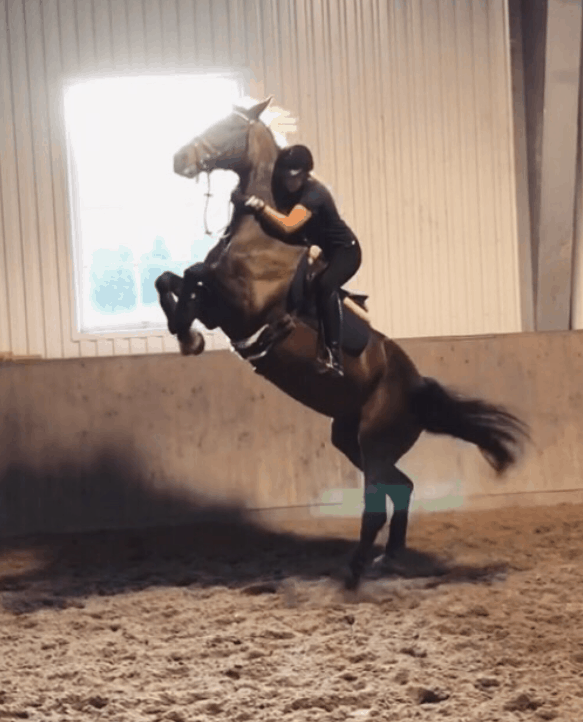
Any experienced rider will at some stage have encountered a frightening situation on horseback and it is very normal for someone yet to try horse riding to ask this question. Horses can be intimidating, and they also have their own will and personality, which can cause unforeseen and frightening reactions.
So, is horse riding scary? There are inherent dangers with equestrian sports and horse riding can be scary. How scary horse riding feels will vary from person to person and usually depend on the temperament of the horse you ride. Having a healthy fear of injury is however positive as it will help you take precautions and prevent you from making reckless decisions when riding.
So how scary horse is riding? Answer: it depends. Helpful right? Well, unfortunately, it impossible to predict how scary or not scary it will be for you to ride as it depends so much on your individual traits as well as the horse and the conditions under which you ride. BUT, while we could give you a host of advice on how to overcome fear, we will actually here focus on the most common scary situations riders tend to experience, our stories about them and tips for what you can do when one day you face them as well.
What Makes Horse Riding Scary?
What makes horse riding scary for me can be different from what makes it scary for you. That said, some of the most common fears we hear from novice riders are:
- The size of the horse and distance to the ground when mounted. The size of a horse when you are up close can be pretty intimidating but guess what – not all horses are created equal. If you are worried about size and how high you will be above sea level once you are mounted, you can always request a pony or a smaller horse. How small you can go will depend on your size and level of experience as we explain in more detail in our article about weight limits for horse riding.
- The unpredictable nature of horses. Horses are individuals just like us. They have personalities just like us. Some are people-pleasers and always willing to listen. Others are more insecure and easily distracted. It takes time to learn how to read a horse’s behavioral cues. Some of which can help predict certain sudden actions and movements. A good trainer will be able to interpret those cues for you as you start out and help you maneuver through them. Also, keep in mind that a good equestrian center will never put their beginners on very nervous or energetic horses.
- The fear of falling off the horse. This one needs little explanation and is perfectly valid. Most people who practice horse riding for a longer period will at some stage experience falling off. It is not fun, not pleasant, and depending on the circumstances can be dangerous. It is positive to have a healthy fear of falling, but it should not be crippling. Unfortunately, the only way to really reduce the fear of falling off the horse is gaining confidence in riding. It’s a bit of a ‘the chicken or the egg’ situation where you must face your fear, and as you become a more confident rider, your fear of falling off will diminish proportionally.
It is perfectly normal to be anxious about doing something that is unchartered territory and completely unfamiliar to you. The horse is a large animal and it takes a certain level of experience to understand their behavioral patterns and even more to predict their reactions. This is why a good instructor who is supportive of nervous riders is key to helping you get comfortable in the saddle and handling horses confidently.
3 Scary Riding Situations and How to Handle Them
We have both ridden a lot of different horses with hugely different temperaments and levels of training. But across all the experience, there are a few typical scary situations that most riders are bound to experience one time or another.
Horses Getting Spooked
Horses getting spooked happens relatively frequently and in particular on trail rides where they are exposed to more external stimuli such as new sounds, sights, and situations. A horse can be spooked by a sudden sound or movement, such as a bird taking off from a nearby branch or a plastic bag blowing across the path. However, it can also be intimidated by something stationary such as a rain puddle or a car parked along the road. In case you were wondering – yes those are all real examples of what our horses have been spooked by on trail rides. In fact, one of these horses (a Lipizzan) consistently got spooked by a shed along the arena, which she was exposed to several times per week! Insert eye-roll here..
Usually when a horse suddenly gets spooked, it will do a little jump to the side or on the same spot, which may throw the rider a bit off-balance, but usually, it will not take off running. Should the sounds or sight of the spook persist though, the horse’s natural instinct will be to escape from the perceived danger by running away. The things horses get spooked by can often seem a bit ridiculous to us, but it’s important to remember that these reactions are based on primal survival instincts. Imagine if someone held you back from escaping a burning building and how that would make you feel.
When riding a horse that get spooked, it is important to manage your own stress. Focus on breathing calmly and relax your body. Once the horse is standing still, give him time and let him look at the thing that spooked him without demanding anything else. Once he seems to be a bit calmer, you can ask him to move forward again. If you are riding in a group, following other horses that aren’t affected or scared can be very helpful.
If possible, it can be a good idea to create more distance between yourself and the source. If the horse does not calm down and you don’t feel in control of the situation, consider taking another route or returning to the stables.
Horses Taking Off with a Rider

Sometimes a horse can get so spooked that it takes flight from the danger it perceives. Another situation where horses can take off with a rider is when a canter develops into an uncontrolled gallop, especially in groups where the horses may want to race each other.
Being on a horse when you no longer feel in control of it is definitely scary and highlights what a powerful animal this is. We have experienced this several times but have luckily always managed to stay on and regained control. If a horse takes off with you, this is where you’d want to employ the emergency stop technique called Pulley Rein. The video below explains how to do this maneuver, which is the way we were usually able to rein in our horses when this happened to us.
Horses Bucking and Rearing
Bucking and rearing can happen in connection with a horse being spooked or taking off, but it can also be an isolated event. This behavior can be a sign of discomfort, stress or disobedience. Bucking can also be an expression of excitement and happiness, so reading the horse’s body language is important to understand the underlying reasons. Regardless of that though, being a rider on a horse trying its best to throw you off can be both scary and very uncomfortable.

A particular pony at our riding school (we shall not name any names) had a nasty habit of bucking fiercely so we’ve had our fair share of involuntary ‘rodeo performances’ in the arena growing up. The shock to the back, neck, and shoulders can be quite painful and staying on rather challenging!
A horse can only buck with its head down, so the key to disarming this behavior is to sit deep in the saddle, lean lightly backward and give strong pulls on the reins to lead its head upwards. And beyond managing the specific situation it would be important to try and understand why the horse is behaving in this manner in the first place. Few (if any) horses are vicious and their behavior can usually be traced back to physical or psychological issues.
Similarly to bucking, rearing can occur for a number of reasons such as excitement, aggression, fright or pain. When a horse rears, it is important to lean forward, position your head on either side of the horse’s neck to avoid bumping heads with the horse, grab hold of its neck and pull the reins in your free hand downwards. Below is a great video that illustrates exactly how to do this.
As much as we’d love to say horse riding is never scary – that is simply not true. But we hope these insights will help you be better prepared once those scary situations happen to you!
This article is accurate and true to the best of the author’s knowledge. It is not meant to substitute diagnosis, prognosis, treatment or any type of medical advice for humans or horses. Animals exhibiting signs and symptoms of distress should be seen by a veterinarian immediately.


